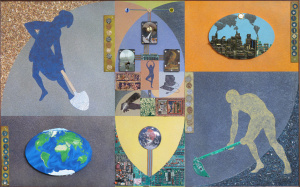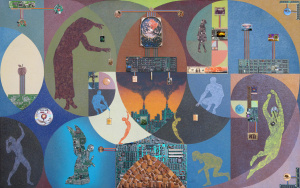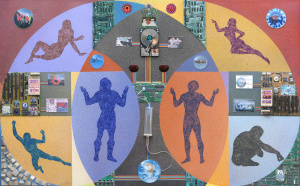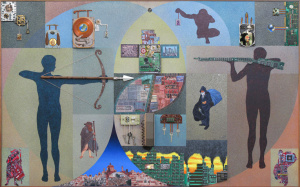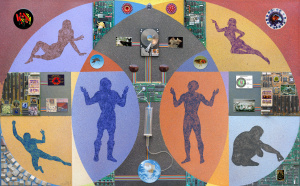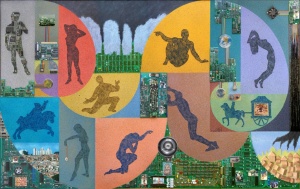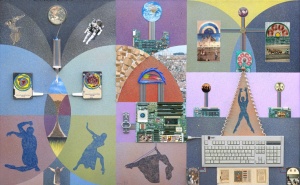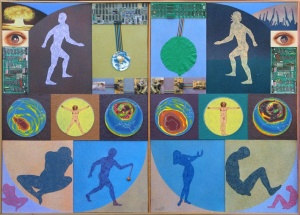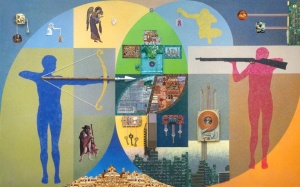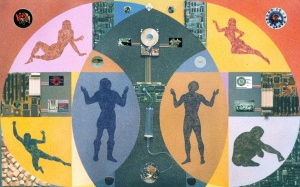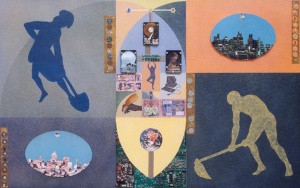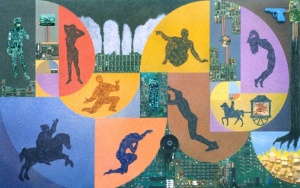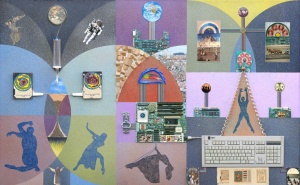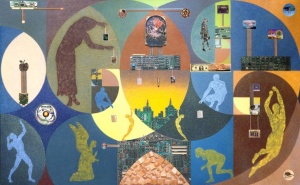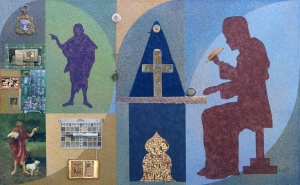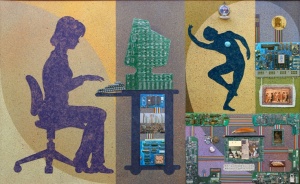As I have written previously, I have expressed through my work the issues of daily life that afflict me conceptually and ideologically. So it was with the 1984 series "1984 - George Orwell's Stigma", "Brave New World" and "Seattle Project", among other, where I used pieces of computers and commonplace objects incorporated to the traditional technique of oil painting. In that way, the reason of existence of this exhibition could not be different.
Since the 1980s, when analyzing human attitudes in our time and trying to understand their trajectory through comparisons with the past, through personal studies of human history, I came across a strong parallel in history: the Middle Age.
The whole sense of violence; insecurity; loneliness; social despair; risks of epidemics; religious control; professional relations; spatial displacement; dependence on the government; social injustices; personal anxieties etc., which currently occur in our societies, have, in my view, a certain similarity with that historical period.
Hence this new series of works, the Brave New Middle Ages, was born where my intention is to provoke in the viewer reflections on the present and the future using the experiences of the past in an analogous approach to the cyclical space time continuum, although I imagine that time should not be represented exactly by a circle, but by a spiral (much more dynamic, as life is), which has some apparently cyclical characteristics, because it is born at one point and grows continuously passing through the same quadrants that cause certain similarities, but without repeat itself. The term "Brave" is derived from the series of paintings I painted based on the book Brave New World written by Aldoux Huxley.
Returning to the historical parallel mentioned above, we know that in the Middle Ages the movement of people from one region to another was very slow, as the fastest means of locomotion was carried out by means of horses. Today the speed of traveling in large cities reaches the same parameters as in the Middle Ages due to traffic jam. Within today's cities, it takes the same time as in the Middle Ages to travel 20 kilometers, for example.
Just as in the Middle Ages there was an informal structure for trade and provision of services and nowadays the informal economy has been strengthening in large cities. There were people who hired the services of artisans, leaving the raw material in their homes and periodically passing to pick up the finished product. Today, many companies outsource their activities by supplying raw materials to people hired to perform the service in their own homes and return it in the form of manufactured items. Other companies hire independent professionals to carry out delivery and transportation services, the well-known uberization. In addition, with the advancement of information technology, many professionals and executives are doing their work at home and sending the outcome to the companies that hired them, the so-called home office.
In the Middle Age, cities were surrounded by high walls and gates, which were closed at night, in order to protect themselves from external attacks. Next to these walls and gates, archers were stationed, watching the approach of possible enemies. As a parallel, we have today, closed condominiums or even commercial and residential areas, where security companies are hired for the same purpose as before. Thus, armed men guard the entrance and surroundings of residential complexes and communicate through walk talkies. The roads were also extremely dangerous, as are certain streets in today's large cities, and the labyrinthine formation of the streets in slums and poor regions does not differ much from the housing conditions in the Middle Ages. Basic sanitation was also precarious, as in many countries today.
By the time I painted the works in this series, the risk of serious epidemics was already a concern for some health authorities worldwide, due to the ease with which viruses and bacteria can be transmitted. This has raised the same concerns, as there were in the Middle Ages with plagues, now realized with the current Covid-19 pandemic.
The current spread of religions and spiritual manipulation today has not been much different from the Manichaeism practiced by religious leaders in the Middle Ages. Likewise, the proximity of the end of the last millennium provoked several catastrophist predictions similar to those of the end of the first millennium and associated to the end of the world. As if these issues were not enough, during the Middle Ages, there was also a violent and fierce religious persecution that is repeated today with great frequency and omnipresence.
Just as in the Middle Ages there was an informal structure for trade and provision of services and nowadays the informal economy has been strengthening in large cities. There were people who hired the services of artisans, leaving the raw material in their homes and periodically passing to pick up the finished product. Today, many companies outsource their activities by supplying raw materials to people hired to perform the service in their own homes and return it in the form of manufactured items. Other companies hire independent professionals to carry out delivery and transportation services, the well-known uberization. In addition, with the advancement of information technology, many professionals and executives are doing their work at home and sending the outcome to the companies that hired them, the so-called home office.
As in the Middle Ages, today's cities are real centers of new ideas, technologies and power, where rulers are generally overbearing and remain isolated from the population. However, the Middle Ages were not exactly an era of obscurantism as many think, and perhaps our era is also not as dark as some pessimists claim. In this sense, some believe that we are on the threshold of a new era. If this belief is real, let us hope that the New Renaissance does not take long to arrive, since everything has evolved and changed extremely quickly in our times (probably more significant events occurred in the 20th century than in all of human history).
With all this, the New Middle Ages that we live today, despite its dichotomies, seems to me as admirable as that experienced by our ancestors, and this encouraged me to continue expressing my disappointments and hopes through the logical and playful reuse of waste of our technological daily life against elements representative of the Middle Ages.
By respecting the persistent recurrence in the use of some symbolic elements, such as the image of the planet Earth, seeds and leaves, as well as images of dancers (used in other series of works), in this series I try to express the situation of man's existential imbalance in relation to the planet, today. In this way, I try to create an analogy, through the counterpoint between the elements referring to the Middle Ages and the elements representative of contemporary times.
The constructivist composition of the paintings through the Golden Ratio, used in its dimensions, generates pictorial plans achieved through textures and overlays of paint in splashed, wrinkled, abstract and gestural layers. However, these rigid geometric planes are attenuated with the use of the elegant and organic lines of the logarithmic spiral (for me associated with the rhythm of life and time) and with the use of chromatic harmonies resulting from extensive research on color.
The outcome, I believe, is formed by unconventional contemporary pictorial works, where the symbolic universe exerts great visual force on the spectator.
Walter Miranda – 1998/2022
[ALL THE SERIES WORKS]
